AiPrise
13 mins read
August 13, 2025
How to Identify a Fake US Passport: A Guide to Preventing Fraud
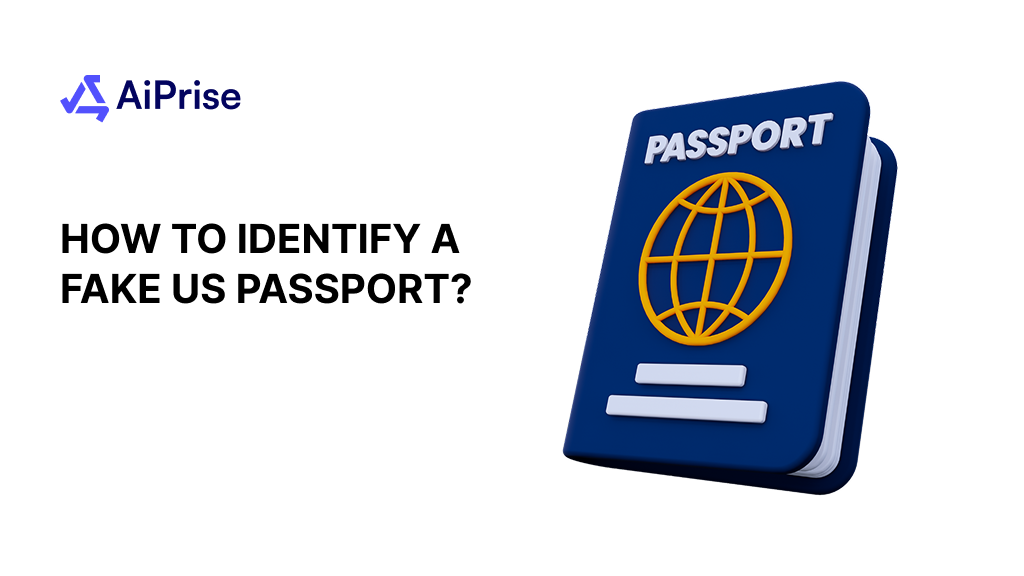
Key Takeaways










In a globalized world, the U.S. passport is the gold standard of identity, but its value makes it a prime target for criminals. According to the Financial Crimes Enforcement Network (FinCEN), identity-related suspicious activity accounted for $212 billion in illicit activity in a single year, with impersonation tactics being the most frequently reported typology.
Passport fraud is a complex and evolving challenge. As criminals use advanced technology to create deceptive documents, the traditional methods of detection are no longer sufficient. Businesses, governments, and individuals must be more vigilant than ever.
This guide will provide a comprehensive overview of how to identify a fake U.S. passport, the key security features to check for, and the actionable steps you can take to prevent fraud and protect against this growing threat.
Key Takeaways
- Fake U.S. passports come in various forms, including altered, forged, and counterfeit documents, each with distinct characteristics that can be detected through close inspection.
- Genuine U.S. passports feature multiple layers of security, including optically variable inks, laser-engraved data, and embedded electronic chips, which are difficult for criminals to replicate.
- Businesses and authorities must use a combination of physical inspection, UV light scanning, and AI-powered digital verification to accurately and efficiently detect fraudulent passports.
- AiPrise offers comprehensive solutions to streamline identity verification, detect fraudulent activity early, and ensure compliance with global regulations.
Before we talk about identifying a fake US passport, let's first understand the different types of US passports.
What Is Passport Fraud?
Passport fraud is an act of intentional deception that involves the forgery, alteration, or misuse of a passport to commit a crime. It is a significant and growing problem, as a U.S. passport is one of the most valuable identity documents in the world. Criminals use fake passports to conceal their identity and facilitate serious illegal activities, including:
- Identity Theft: Using another person’s information to open financial accounts, commit tax fraud, or take out loans.
- Illegal Immigration: Gaining unauthorized entry into a country or bypassing visa requirements.
- Terrorism and Criminal Activity: Concealing a person's true identity to evade authorities, transport contraband, or finance illicit operations.
To effectively combat this threat, it is crucial to understand that passport fraud is not a single crime, but a broad category of illegal acts.
Types of Passport Fraud
There are several types of passport fraud, each with its own characteristics:
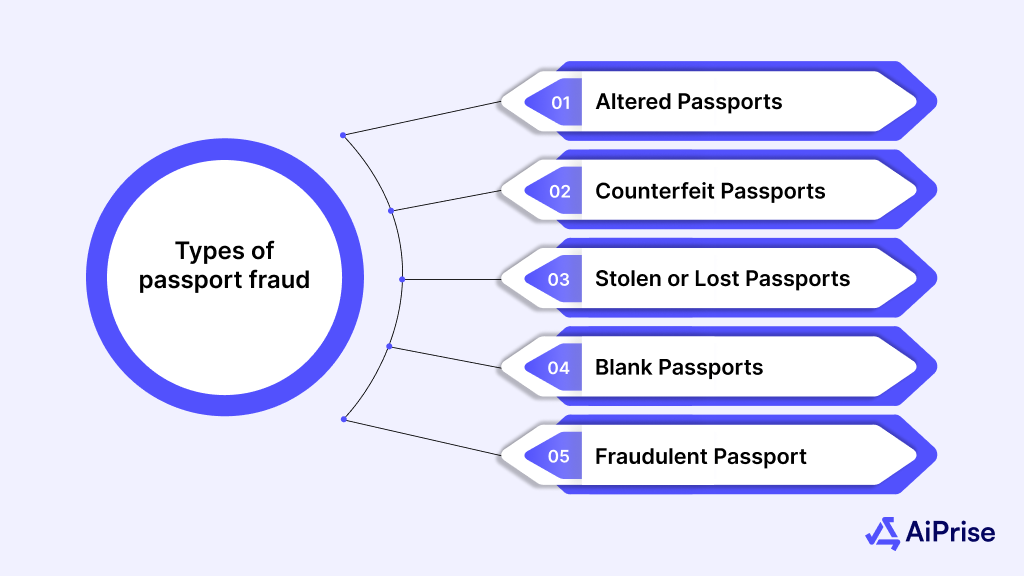
- Altered Passports: These are real passports that have been tampered with. This can involve replacing the photo, changing the name, or altering the date of birth. While the document is genuine, the data on it has been compromised.
- Stolen or Lost Passports: A passport that has been reported as lost or stolen is still a genuine document, but it is no longer valid. Fraudsters may use these documents for illegal purposes, but they can be easily flagged by authorities using verification databases.
- Blank Passports: This is a particularly dangerous form of fraud where criminals gain access to genuine, unissued passport booklets. They then insert false data and a fraudulent photo into the authentic document. As the document's core security features are real, these are extremely difficult to detect without advanced digital verification.
- Fraudulent Passport Applications: This is a method of fraud where criminals submit fake or stolen documents (e.g., a forged birth certificate) to the Department of State to obtain a legitimate, authentic passport under a false identity. In this case, the document is real, but the identity behind it is not.
- Counterfeit Passports: These are entirely fake documents produced from scratch to mimic a genuine U.S. passport. They are often created in large batches but typically fail to replicate the sophisticated security features perfectly.
This last method, in particular, is a growing problem. For example, recent data from the U.S. Department of the Treasury's Financial Crimes Enforcement Network (FinCEN) highlights that between 2018 and 2023, fraud involving counterfeit U.S. passport cards led to millions of dollars in losses and affected thousands of victims.
With this understanding of the types of passport fraud, let's explore how genuine passports are designed to prevent it.
Key Features of a Genuine US Passport
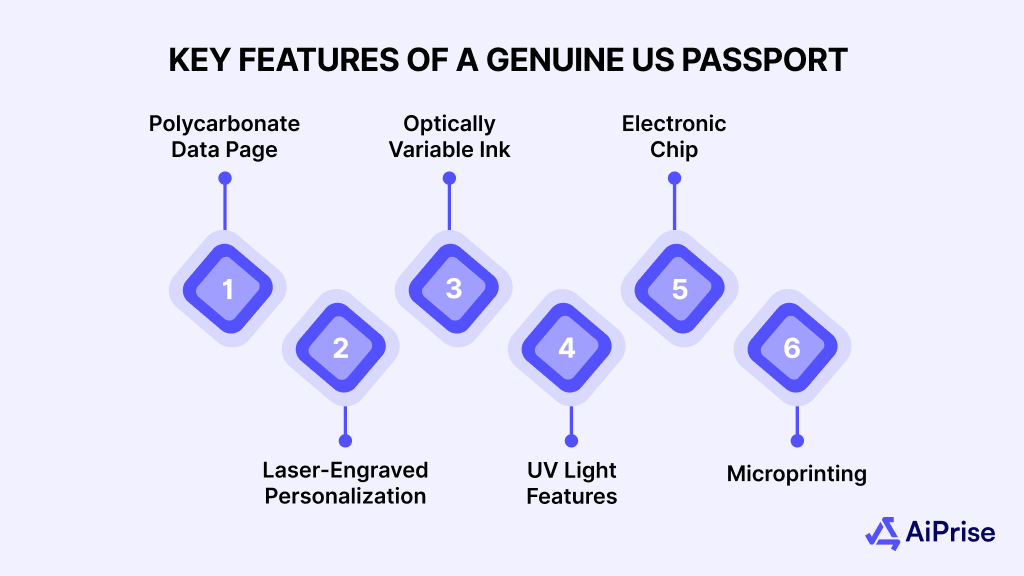
A genuine U.S. passport is not just a booklet with your photo; it is a highly secure document engineered with multiple layers of protection to prevent counterfeiting and fraud. Understanding these features is the first step in identifying a fake document.
Here's what makes a real passport secure:
- Polycarbonate Data Page: The biographical page is no longer paper-based. It is made from a rigid, durable polycarbonate material that is resistant to tampering and cannot be easily peeled or delaminated.
- Laser-Engraved Personalization: Instead of ink-jet printing, the holder's photo and personal details are etched directly into the polycarbonate using a laser. The portrait is a black and white image that is an inseparable part of the page itself.
- Optically Variable Ink (OVI) & Color-Shifting Images: Modern passports feature special inks and holographic images that change color or appearance when tilted. These dynamic features are highly complex and difficult to forge.
- UV Light Features: A number of advanced security features are hidden and only become visible under ultraviolet (UV) light. This includes fluorescent fibers embedded in the paper, as well as invisible images and text on the data page and throughout the passport.
- Electronic Chip (e-passport): All modern U.S. passports contain an embedded electronic chip, making them "e-passports." This chip securely stores the holder's personal data and a digital version of their photograph, which can be read by specialized equipment to verify authenticity.
- Microprinting: The document is filled with tiny, intricate text that is very difficult to read with the naked eye. This microprinting is a key anti-counterfeiting measure that often appears blurred or illegible in counterfeit documents.
Now that you know what a genuine U.S. passport looks like, here are the actionable steps to detect a fake one.
How to Spot a Fake US Passport?
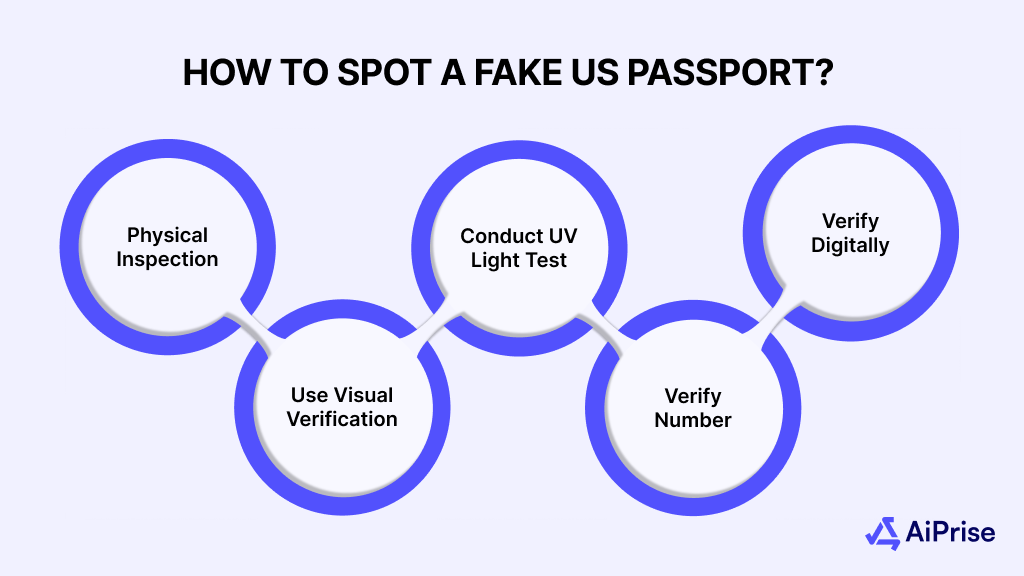
Detecting a fraudulent passport requires a keen eye for detail and an understanding of how criminals attempt to compromise the security features mentioned above. When inspecting a passport, follow these specific steps to uncover signs of fraud:
- Perform a Physical Inspection:
- Feel the Data Page: A genuine passport's data page should feel like a smooth, hard plastic card. Look for any signs of bubbling, peeling, or a flimsy texture, which indicate a fraudulent lamination attempt.
- Check the Engraving: Run your finger over the photo and personal details. The surface should feel slightly raised or textured. If the photo feels like a sticker or looks like it could be peeled off, it is a significant red flag.
- Use Visual Verification:
- Check for Color-Shifting: Tilt the passport under a light source. The passport's seal and other images should change color smoothly and clearly. A static image or one that looks dull and flat is a sign of a poor-quality fake.
- Inspect the Microprinting: Use a magnifying glass to check for the tiny, intricate text. The text should be sharp and readable. If it appears blurry, smudged, or distorted, the passport is likely counterfeit.
- Conduct a UV Light Test:
- Look for Hidden Features: Under a UV light, a genuine passport will reveal fluorescent fibers and a variety of hidden images and text. The absence of these features or a sloppy replication is one of the most reliable indicators of a fake document.
- Verify the Passport Number:
- Examine the Font and Spacing: U.S. passports use a specific, difficult-to-replicate font for the passport number. Check for uneven spacing, smudging, or a font that looks incorrect, as these can indicate a fake.
- Check the Format: U.S. passports follow a specific alphanumeric sequence. A mismatch in this format or a number that doesn't align with an official database is a strong signal of a counterfeit.
- Verify the Passport Digitally:
- Scan the E-Passport Chip: A passport equipped with an electronic chip can be scanned to cross-reference the data with the information printed on the page. This digital verification can quickly expose inconsistencies, altered data, and other forms of fraud that are invisible to the naked eye.
By using these methods and paying attention to the finer details, you can effectively detect a fake U.S. passport. But what if you identify a fake U.S. passport? How can you prevent falling victim to them?
What to Do If You Suspect a Fake U.S. Passport?
If you suspect a U.S. passport to be fake, it’s important to take immediate and appropriate action. Identifying fraudulent passports can help prevent illegal activities such as identity theft, smuggling, and other criminal offenses.
Follow this 6-step guide if you suspect a fake U.S. passport:
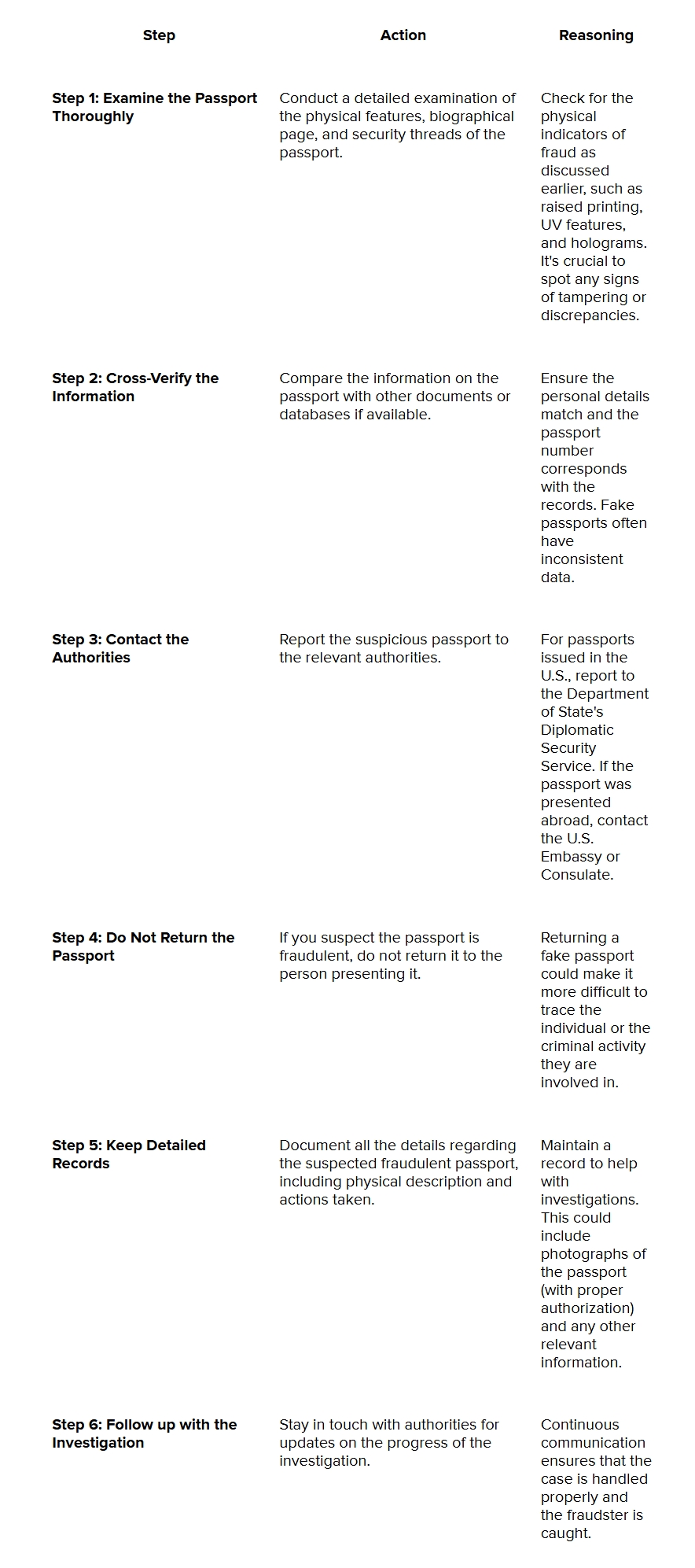
What Happens When You Report Passport Fraud?
Once a fraudulent passport is reported to the proper channels, various government agencies and law enforcement entities spring into action. The Diplomatic Security Service (DSS) leads these investigations, often in coordination with other federal and international partners.
Some of the common actions taken include:
- Investigating the Source: DSS special agents work to trace the origin of the fraudulent document and attempt to uncover who produced or altered it.
- Cross-Checking the Information: They cross-check the passport details with various federal databases to confirm the individual’s identity and determine if they are linked to other criminal activities.
- Coordination with International Law Enforcement: For passports used outside the U.S., the DSS will coordinate with international agencies like Interpol to track down suspects and dismantle criminal networks.
- Legal Action: If the passport is confirmed to be fraudulent, the individual is typically arrested and prosecuted under federal law, which carries severe penalties.
While authorities play a vital role in investigating and handling fake U.S. passport cases, businesses also have a crucial responsibility to safeguard against such fraud. Here’s how AiPrise helps companies effectively detect and prevent fake U.S. passport fraud.
How AiPrise Helps Businesses Detect and Prevent Fake U.S. Passport Fraud
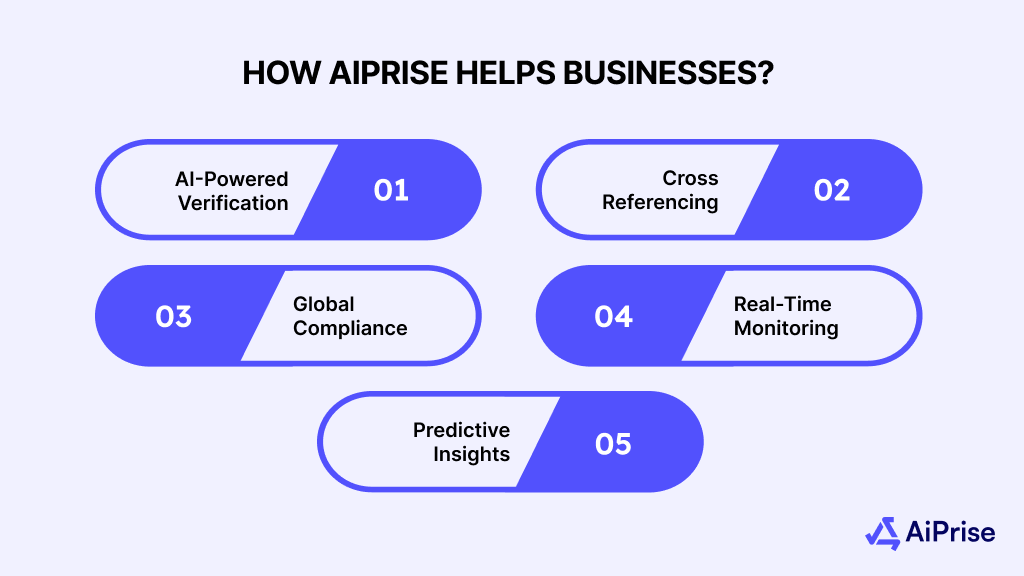
In the fight against fake U.S. passports and visa fraud, businesses need reliable solutions that help detect fraudulent documents and ensure regulatory compliance. AiPrise offers a comprehensive platform designed to protect businesses from the risks associated with fake identity documents, including U.S. passports.
AiPrise uses cutting-edge technology to provide businesses with tools that accurately identify fraudulent passports in real-time, ensuring both regulatory compliance and fraud prevention.
Here’s how AiPrise adds value:
- AI-Powered Document Verification: AiPrise uses advanced AI algorithms to scan U.S. passports and visas for signs of alteration, such as photo mismatches, tampered information, and other visual discrepancies. The platform offers real-time validation, providing businesses with immediate alerts when fraudulent documents are detected.
- Cross-Referencing with Trusted Databases: AiPrise cross-references passport data with multiple authoritative sources, including government and third-party databases. This helps verify the legitimacy of passports, reducing the chances of fraud entering your system and ensuring that your compliance is aligned with local and global regulations.
- Global Compliance Assurance: Navigating complex international regulations is challenging, but AiPrise ensures businesses stay compliant with ever-evolving KYC and visa verification standards. With AiPrise, businesses can be confident in meeting the requirements set by immigration authorities worldwide.
- Real-Time Monitoring and Fraud Detection: AiPrise offers continuous monitoring of passport and visa transactions, immediately flagging suspicious activities for investigation. This proactive approach ensures businesses can act swiftly to prevent any fraudulent activity before it escalates.
- Fraud Analytics and Predictive Insights: Through machine learning and data analysis, AiPrise identifies emerging fraud trends and improves the fraud detection process over time. By understanding patterns in fraudulent activities, businesses can strengthen their fraud prevention measures and stay ahead of criminals.
By integrating AiPrise into your fraud prevention strategy, businesses can safeguard against the use of fake U.S. passports and visa fraud, streamline verification processes, and minimize operational risks. AiPrise’s comprehensive solutions help companies detect and prevent fraud at scale while maintaining seamless compliance with complex regulations.
Conclusion
Fake U.S. passports pose a significant threat to businesses, especially those involved in international travel and immigration services. Understanding the types of passport fraud and knowing how to identify them is crucial for reducing risks.
AiPrise offers AI-powered document verification tools that help businesses detect altered and counterfeit passports in real-time, ensuring compliance and mitigating fraud risks. With continuous monitoring and cross-referencing with trusted databases, AiPrise empowers businesses to stay ahead of fraudsters.
To protect your business from the risks of fake U.S. passport fraud, Book A Demo today and see how AiPrise can enhance your fraud detection systems.
FAQs
1. How to check if a US passport is real or fake?
To check if a U.S. passport is real or fake, closely inspect its security features such as watermarks, UV light-reactive images, and microprinting. Verify the passport's integrity with tools like magnifying glasses or UV light to look for discrepancies. Any tampering or poor-quality print could indicate a counterfeit.
2. How does Visa detect fraud?
Visa fraud detection is achieved through a combination of AI-driven systems, behavioral analytics, and real-time transaction monitoring. These systems look for unusual patterns, such as high-value transactions from new or unknown locations, and flag them for review. Additionally, Visa cross-references transaction data with global databases to catch fraudulent activities early.
3. How can AI help detect fake US passports?
AI technology analyzes passport data, comparing it to trusted databases and identifying any irregularities, such as photo mismatches or altered information. AI also scans for missing or poorly replicated security features, flagging suspicious documents in real-time.
4. What is the role of UV light in detecting fake passports?
UV light is used to reveal hidden security features in genuine passports, such as UV-reactive images and microprinting, which counterfeit documents lack. By using UV light, you can identify discrepancies that indicate a passport may be fake.
5. How do fraudsters alter passports?
Fraudsters often alter passports by modifying personal details, such as names or photos, or by using counterfeit materials to create entirely fake documents. They may also tamper with the document’s security features, such as holograms, to make it appear genuine.
You might want to read these...

Aiprise has helped streamline our KYB (Know Your Business) flow in 100+ countries. No other tool comes close.





Speed Up Your Compliance by 10x
Automate your compliance processes with AiPrise and focus on growing your business.





